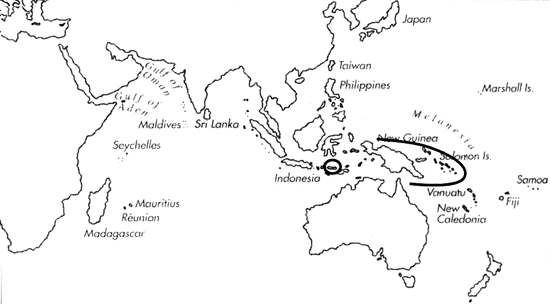Range: Papua New Guinea and Solomon Is; probably Indonesia (Flores) and New Caledonia.
Description: Moderately small, moderately solid. Last whorl conical, outline nearly straight. Shoulder angulate to subangulate. Spire of low to moderate height, outline straight to slightly convex. Teleoconch sutural ramps flat, with 1-2 increasing to 3-4 spiral grooves; spiral sculpture often weak on last ramps. Last whorl with widely spaced spiral ribs at base.
| Shell Morphometry | ||
|---|---|---|
| L | 24-32 mm.09 | |
| RW | 0.15-0.15 g/mm | |
| RD | 0.59-0.66 | |
| PMD | 0.86-0.89 | |
| RSH | 0.10-0.14 | |
Last whorl brownish olive or bluish brown, with a bluish grey line at shoulder edge and a bluish grey spiral band at centre; central band usually with spiral rows of brown dots. Dotted brown spiral lines may also be present on basal third. Larval shell brown. Teleoconch sutural ramps irregularly maculated with tannish olive and bluish grey; outer margins bluish grey with irregular brown markings. Aperture bluish white or light violet deeper within; central pale band variably distinct.
Habitat and Habits: Intertidal to about 100 m; on dark sand bottom.
Discussion: C. gilvus resembles C. hyaena concolor, which can be separated by its larger size (40-57 mm), sometimes narrower last whorl (RD 0.56-0.65), and by the larger number of spiral grooves on its late sutural ramps. For comparison with C. flavidus and C. frigidus, see the DISCUSSIONS of these species.

C. gilvus range map
This section contains verbatim reproductions of the accounts of 316 species of Conus from the Indo-Pacific region, from Manual of the Living Conidae, by Röckel, Korn and Kohn (1995). They are reproduced with the kind permission of the present publisher, Conchbooks.
All plates and figures referred to in the text are also in Röckel, Korn & Kohn, 1995. Manual of the Living Conidae Vol. 1: Indo-Pacific Region.
The range maps have been modified so that each species account has it own map, rather than one map that showed the ranges of several species in the original work. This was necessary because each species account is on a separate page on the website and not confined to the order of accounts in the book.